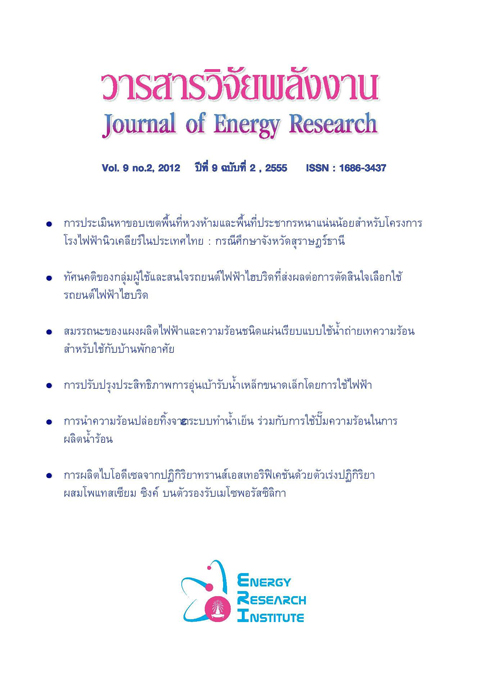การประเมินหาขอบเขตพื้นที่หวงห้ามและพื้นที่ประชากรหนาแน่นน้อยสำหรับโครงการโรงไฟฟ้านิวเคลียร์ในประเทศไทย: กรณีศึกษาจังหวัดสุราษฎร์ธานี
Main Article Content
Abstract
การประเมินขอบเขตพื้นที่หวงห้ามและพื้นที่ประชากรเบาบางรอบโครงการโรงไฟฟ้านิวเคลียร์ในสถานที่ตั้งที่คาดว่าจะมีการสร้างโรงไฟฟ้านิวเคลียร์ของประเทศไทยในอนาคต โดยอ้างอิงกฎเกณฑ์ของคณะกรรมาธิการกำกับดูแลนิวเคลียร์แห่งสหรัฐอเมริกา (U.S.NRC) ในการประเมินขอบเขตพื้นที่หวงห้าม (EAB) และพื้นที่ประชากรหนาแน่นน้อย (LPZ) จากการจำลองการแพร่กระจายโดยใช้โปรแกรมสำเร็จรูป Hotspot ที่ประยุกต์การใช้สมการเกาส์เซียนพลูมในการวิเคราะห์ผลกระทบต่อประชาชนด้วยปริมาณรังสีสมมูลย์ที่ร่างกายได้รับทั้งหมด (TEDE) ตามการออกแบบเพื่อป้องกันอุบัติเหตุขั้นพื้นฐานกรณีสูญเสียน้ำระบายความร้อน (DBA LOCA) ที่ระยะ EAB และ LPZ ต้องไม่เกิน 25 เร็ม (0.25 ซีเวิร์ต) ภายในระยะเวลา 2 ชั่วโมงและ 30 วันตลอดเวลาที่กลุ่มควันกัมมันตรังสีเคลื่อนตัวผ่านตามลำดับจากเครื่องปฏิกรณ์ที่ได้รับการรับรองจาก U.S.NRC ซึ่งใช้ข้อมูลที่ให้ผลร้ายแรงในการประเมิน ผลการศึกษาพบว่า ขอบเขต EAB สำหรับเครื่องปฏิกรณ์ AP1000 และ US-APWR คือ 1,300 และ 850 เมตรตามลำดับเมื่อปริมาณรังสี TEDE มีค่าไม่เกิน 25 เร็ม ส่วนเครื่องปฏิกรณ์ U.S.EPR และ ESBWR มีค่า 910 และ 700 เมตรตามลำดับเมื่อปริมาณรังสี TEDE มีค่าเพียง 12 เร็มเท่านั้น โดยขอบเขต LPZ สำหรับเครื่องปฏิกรณ์ AP1000, US-APWR, U.S.EPR และ ESBWR มีค่า 2,200, 2,700, 3,200 และ 4,500 เมตรตามลำดับเมื่อปริมาณรังสี TEDE มีค่าไม่เกิน 25 เร็ม ดังนั้นพื้นที่ศึกษาสุราษฎร์ธานีผ่านเกณฑ์ของ U.S.NRC ในทุกด้านที่เกี่ยวกับการประเมิน EAB และ LPZ โดยไม่มีศูนย์กลางประชากรมากถึง 25,000 คนตลอดอายุการใช้งานของโรงไฟฟ้านิวเคลียร์จากการคาดประมาณประชากรเป็นเวลา 60 ปีโดยเริ่มศึกษาตั้งแต่ปี พ.ศ. 2554
Evaluation of Exclusion Area Boundary and Low Population Zone for Thailand Nuclear Power Plant : Case Study of SURATTHANI Province
Nithima Lojai and Doonyapong Wongsawang
Department of Nuclear Engineering, Faculty of Engineering, Chulalongkorn University
The objective of this study was to evaluate the restricted zones of nuclear power plants at the potential sites of Thailand's future nuclear power plant constructions. The regulations of U.S. Nuclear Regulatory Commission (U.S. NRC) were adopted for the evaluation of Exclusion Area Boundary (EAB) and Low Population Zone (LPZ). Calculations were based on Design Control Documents (DCD) and the plume dispersion computer code Hotspot, which implemented the Gaussian plume model in analyzing the Total Effective Dose Equivalent (TEDE). The TEDE at the EAB and LPZ distances must not exceed 25 Rem (0.25 Sv) within 2 hours and 30 days of radioactive plume passing by, respectively from reactors approved by the U.S. NRC, where analyzed for worse case that input parameters resulting in severe impacts. Results revealed that EAB of AP1000 and US-APWR are 1,300 and 850 meters respectively when TEDE not exceed 25 Rem whereas U.S.EPR and ESBWR are only 910 and 700 meters respectively when TEDE not exceed 12 Rem. LPZ of AP1000, US-APWR, U.S.EPR and ESBWR are 2,200, 2,700, 3,200 and 4,500 meters respectively when TEDE not exceed 25 Rem. So Surat Thani site passed every aspect of U.S. NRC's regulations related to EAB and LPZ evaluations, not having any population center exceeding 25,000 people for the life of the nuclear power stations, based on estimation of population numbers up to 60 years starting from B.E. 2554.

